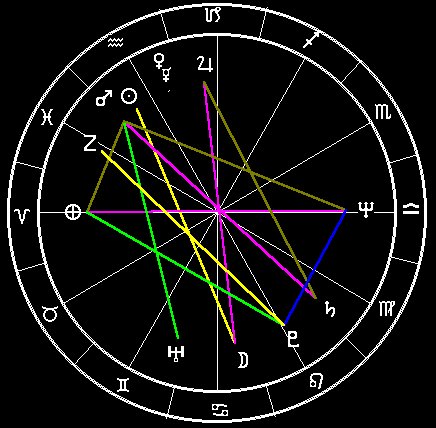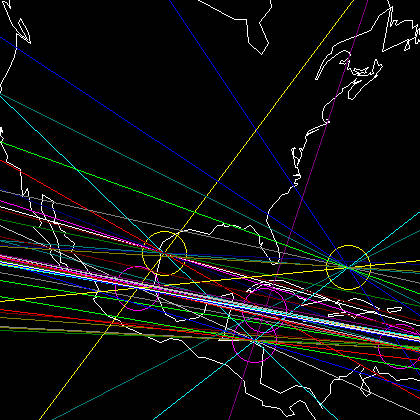By Achernar
This was the way we began - quite a few years ago now.

Relationship Chart - Mr. and Mrs. Achernar
11th Feb 1949 at 04 - 41 - 30 GMT near Samarkand
![]()
We invented the Great Circle method of calculating Relationship Charts properly and we published our methods in 1987.
See arcs of circles as straight lines in Gnomic
Projection !

Along with developing the Astrology of Interplanetary Lines in the Horoscope, we decided to use the gnomic projection, so that great circles on the surface of the Earth would appear as straight lines. On this particular map, the green line is the Interplanetary Line where the plane defined by the triangle Mercury and Venus and the Earth's centre intersects the surface of the Earth in a Great Circle. This is the Mercury-Venus Line. The blue line is the Moon-Jupiter Line, the aqua line is Mercury-Pluto and the red line Venus-Pluto. The yellow circle is centred on where we currently live.
When we relocate to a position close to an Interplanetary Line, we feel the effects! Northern Scotland has a Moon-Jupiter effect for us, The Algarve Coast of Portugal a Mercury-Pluto effect and the Canary islands a Venus-Pluto effect. The only time we have been near our Mercury-Venus Line was when flying over the icesheets at the tip of Southern Greenland - a very Mercury-Venus experience!

This map of North America shows some planets along with the Interplanetary Lines. The prominent yellow line from top right to bottom left of the map passes through the Moon and Jupiter circles (yellow and purple respectively). Yellow circles are at the Zenith Point and purple circles at the Nadir Point. They are drawn larger than life for visibility. We have a clearly depicted Moon-Jupiter opposition here. A purple line runs from the top right of the map to the bottom of the map, passing through the purple circles indicating where Mercury and Venus are at the Nadir - they are in conjunction, and overhead on the opposite side of the world. The other yellow circle is Pluto, and the remaining purple circle is the Sun. Midpoint fans will note that Pluto is roughly equidistant between the Sun and Mercury/Venus.
You will also notice that Pluto is rather to the North of the general line of the other planets, which are closer to the Ecliptic. Many of the Interplanetary Lines tend to run close to the Ecliptic, as one might expect.
One has to be a bit careful when looking at Interplanetary Lines, because there is the possibility that a Local Space Line or a Cartography Horizon or Meridian Line passes through a location, but we believe that looking at Interplanetary Lines can be helpful. It is certainly interesting!
These maps were produced using Achernar Astrology, though the quality of the images has been reduced to give reasonable file sizes.

Last Updated:
October 23rd 1999
Thank you for visiting